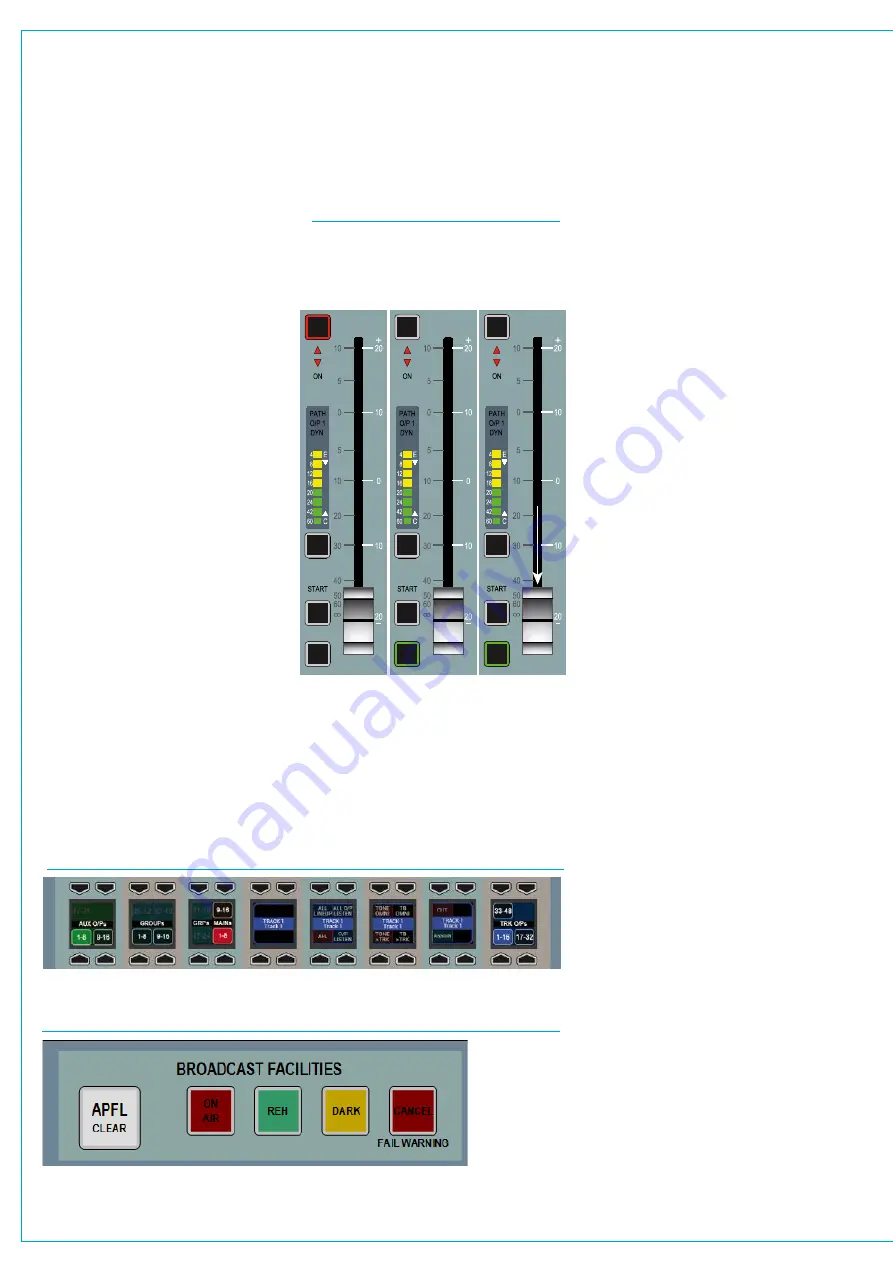
Digital Broadcast Production Console
AFL AND PFL AND OUTPUT LISTEN
Artemis consoles have a
comprehensive multi-user AFL, PFL
and Output Listen system.
AFL
Selecting an AFL - ‘After Fader Listen’,
replaces the output of the control room
monitor with the post fader audio of the
path being AFLd. AFL provides a ‘non-
destructive solo’- Only the control room
monitor output is affected, no paths are
cut, and mixes to all other buses and
outputs are unaffected, allowing users
to quality-check selected paths whilst
maintaining all mixes.
Whilst in AFL mode, the control room
monitor selection display will indicate as
AFL. When all AFLs are switched off,
or globally cancelled, the monitoring will
revert to outputting its previously selected
source.
PFL
PFL - ‘Pre Fader Listen’ is sent by default
to a dedicated PFL/RTB LS output
(RTB is ‘Reverse talkback’ which allows
for signals to be mixed with PFL for
listening on the PFL/RTB output e.g for
use with producer / director hot-mics).
Multiple paths can be PFLd or AFLd at
the same time, creating a summed mix of
pre or post fader path solos.
FIG 1 - FADER AFL & PFL CONTROLS
FIG 2 - ACCESSING AFL AND PFL FOR OUTPUT BUSES
FIG 3 - APFL INDICATOR / CLEAR BUTTON ON BROADCAST FACILITIES PANEL
OutputListen(OPL)
Mains, Tracks, Auxs and Direct Outputs
all have an OUTPUT LISTEN option. Like
AFL, this provides a non-destructive solo,
but output listen takes the feed after the
addition of output delay, directly before the
feed leaves the console.
Accessfromfaders
When a path is attached to a fader, AFL
and PFL can be accessed using the AFL
and PFL buttons. Both are either latching
if tapped briefly, or momentary if held.
By default, PFL is automatically cancelled
when a fader is opened e.g if a fader
reaches
∞
whilst PFL is activated, PFL will
be deactivated when the fader reaches
-90dB.
This feature can be disabled by turning off
the OPEN FADER CANCELS PFL button
within the TOOLS>MISC menu.
PFL can also be activated using the fader
overpress feature: Move the fader down to
its lowest position, then push it down past
the normal backstop position and PFL
activates for that fader. See Fig 1.
This is a momentary setting so as soon as
you release the fader, PFL is deactivated.
If you wish to disable this feature, navigate
to ‘Show Settings’, then select ‘Misc
Settings’ from the left hand button menu
and click DISABLE for the PFL overpress
option.
AccessbusAFL,PFLandOPL
When in Outputs mode, any bus can
be brought into focus in the button cell
row by pushing down on the output’s
rotary control. Once an output is in focus
options appear in the button cell row for
activating PFL and AFL (or OutPut Listen)
for the currently assigned path. See Fig 2.
AccessAFLinContributionMode
When in Contribution mode any Auxiliary,
Track or Group bus can be AFLd by
switching ON on the AFL Selected Aux,
Track and/or Group slider and pressing
the required Bus on the screen.
Note that when another bus is selected
the previous bus AFL is turned off. When
used in conjunction with the ‘AUX SEND
LEVELS’ option the user can listen to the
bus whilst adjusting the levels being sent
to it. See
for details.
Latching or
momentary AFL
using the AFL
button.
Latching or
momentary PFL
using the PFL
button.
Overpress (push
the fader lower
than the normal
backstop) to
activate PFL.
AFL
PFL
DIR
TB
ISO
AFL
PFL
DIR
TB
ISO
AFL
PFL
DIR
TB
ISO
Summary of Contents for Artemis
Page 7: ...calrec com Putting Sound in the Picture ARTEMIS INFORMATION ...
Page 11: ...calrec com Putting Sound in the Picture ARTEMIS INTRODUCTION ...
Page 17: ...calrec com Putting Sound in the Picture ARTEMIS CONTROL OVERVIEW ...
Page 29: ...calrec com Putting Sound in the Picture ARTEMIS CONTROL PANEL MODES ...
Page 36: ...36 ARTEMIS Digital Broadcast Production Console Control Panel Modes WILDABLE CONTROLS ...
Page 39: ...calrec com Putting Sound in the Picture ARTEMIS GETTING SIGNALS INTO ARTEMIS ...
Page 69: ...calrec com Putting Sound in the Picture ARTEMIS PROCESSING AUDIO ...
Page 93: ...calrec com Putting Sound in the Picture ARTEMIS ROUTING AUDIO ...
Page 109: ...calrec com Putting Sound in the Picture ARTEMIS PASSING SIGNALS OUT OF ARTEMIS ...
Page 117: ...calrec com Putting Sound in the Picture ARTEMIS MONITORING ...
Page 132: ...132 ARTEMIS Digital Broadcast Production Console Monitoring ...
Page 133: ...calrec com Putting Sound in the Picture ARTEMIS COMMUNICATIONS ...
Page 138: ...138 ARTEMIS Digital Broadcast Production Console ...
Page 139: ...calrec com Putting Sound in the Picture ARTEMIS METERING ...
Page 148: ...148 ARTEMIS Digital Broadcast Production Console ...
Page 149: ...calrec com Putting Sound in the Picture ARTEMIS SHOWS MEMORIES AND PRESETS ...
Page 163: ...calrec com Putting Sound in the Picture ARTEMIS CONSOLE FACILITIES ...
Page 168: ...168 ARTEMIS Digital Broadcast Production Console ...
Page 169: ...calrec com Putting Sound in the Picture ARTEMIS EXTERNAL INTERFACING ...
Page 180: ...180 ARTEMIS Digital Broadcast Production Console External Interfacing ...
Page 181: ...calrec com Putting Sound in the Picture ARTEMIS SYSTEM STATUS ...
Page 184: ...184 ARTEMIS Digital Broadcast Production Console ...
Page 185: ...calrec com Putting Sound in the Picture ARTEMIS GLOSSARY OF TERMINOLOGY ...
Page 191: ...calrec com Putting Sound in the Picture ARTEMIS FEATURES BY SOFTWARE VERSION ...














































